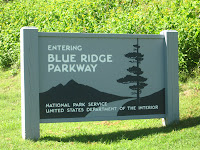Another beautiful day in D.C.! Last weekend (Sept. 18th), we made another trip to Mount Vernon. Not to tour it, like we had before, but to take in some extra sights. On Sat. they were having a Colonial Market & Fair. What we also found out, was that they were offering free boat tours on the Potomac River, so the first thing we did when we got there was to head down to the wharf to get in line & were we glad we did!
The photo on the left is of Mount Vernon from the water. The photo on the right was looking down the river towards DC. You can see the Woodrow Wilson Bridge and the Washington Monument.


These are photos of under the mansion where the sequence with Nicolas Cage & "The President" were filmed. In the movie, they sprayed cob webs all around to make it look like no one had been down there for along time. In George Washington's time it was used to store a lot of the food.
This building was an ice house in George Washington's time. It has a chute that is attached to the side where the slaves would place the ice after bringing it up from the river. This is where the producers got the idea for a tunnel to use in the movie.
Then it was on to the Market Place! They had tents set up for the vendors who were selling things that would have been found in Colonial Times: baskets, pottery, lace makers, ironworks, farm herbs, rugs, wooden toys pewter ware, handmade soap, and much more. Everyone was dressed up in period clothing to make it more authentic.

This woman was using a spinning wheel to make yarn...

And this gentleman said he was employed by General Washington to make sure the area stayed clear of varmints. Can you see what he has in his cage??
As we were getting ready to leave, the soldiers came up to the bolling green in front of the mansion and demonstrated how they would march in formation and shoot. Look at all that smoke from the rifles!! It's no wonder sometimes they shot their own men!! They couldn't see them with all the smoke!!
None of that was on our "list", but it was still very enjoyable!!

















































